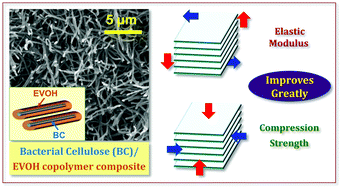Composite hydrogels of bacterial cellulose and an ethylene-vinyl alcohol copolymer with tunable morphological anisotropy and mechanical properties
Abstract
Anisotropic hydrogels that show a direction-dependent structure and properties have been produced and attracted attention in bio-mimicking, tissue engineering and bio-separation. Herein, bacterial cellulose (BC)-ethylene-vinyl alcohol copolymer (EVOH) composites have been prepared by precipitating EVOH within solvent-substituted BC hydrogels via thermally induced phase separation. The internal structures of the composites have been studied by scanning electron microscopy which reveals that the hierarchical structure characteristic of BC is retained in the composites. Depending on the production parameters of the composites like phase separation solvent composition, copolymer composition, phase separation cooling temperature and polymer concentration, the interaction between the BC and EVOH varies and the morphology changes interestingly. A stronger interaction and slow cooling rate uniformly precipitate EVOH over the BC fibers covering it, whereas a weak interaction with fast cooling induces independent precipitation of the copolymer in the BC matrix. Viscoelasticity and compressibility measurements of the composites in the hydrogel state reveal high structural and mechanical strength which are direction dependent, confirming the retention of anisotropy characteristics of the BC structure. The elastic modulus and compression strength are found to be improved significantly upon intercalation of EVOH into the BC structure giving rise to more reinforced composites. High viscoelasticity and compression strength exhibited by the composite hydrogels indicate good mechanical stability that makes them useful as replacement materials for biological tissues.



 Please wait while we load your content...
Please wait while we load your content...